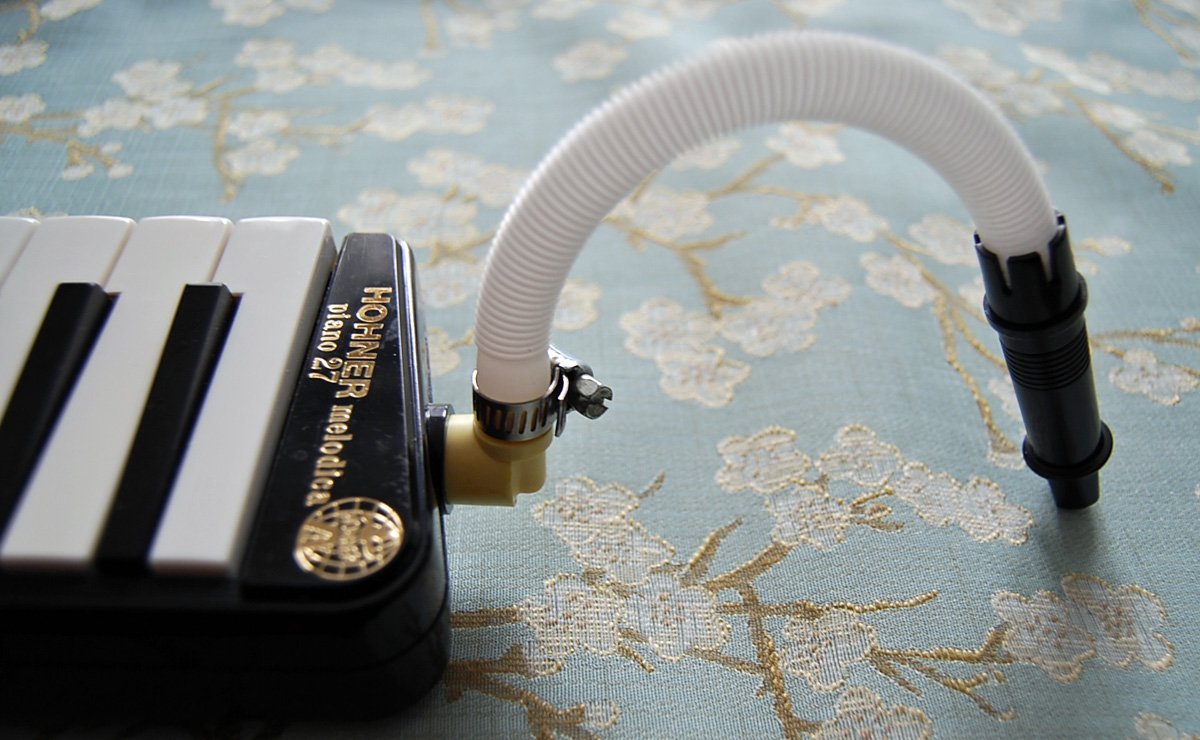Mouthpiece Exploration and Discovery
Tagged: Mouthpieces, tube, vibrator
- This topic has 10 replies, 4 voices, and was last updated 9 years, 1 month ago by
 Lowboy.
Lowboy.
-
AuthorPosts
-
February 22, 2015 at 10:45 pm #4199
 LowboyParticipant
LowboyParticipantHi,
Today I was thinking about mouthpieces, and got into some experimentation as I thought more about using an oboe or clarinet or saxophone mouthpiece. The more I explore, the more I realize how much you can do acoustically if you think outside the box. For example, today I was again humming into the mouthpiece while playing. This is how sax players get that raspy sound on soulful sax solos. Well the same thing happens on melodica. All you do is hum onto the mouthpiece (at least on a Piano 26/27/32) and the sound can really breakup up nicely. Who needs a distortion pedal? (Actually the acoustic breakup sounds different than distortion pedal breakup and I don’t think you could hum all night.) Maybe I don’t need a sax mouthpiece. Plus you can get all sorts of eerie sounds from the voice and melodica interacting. But I digress.
I never thought I would use a tube (photo below), but discovered today, that by using a short tube, I can press the back of my piano 26/27/32s more fully against my chest, enabling much more muffling and a much deeper vibrato, particularly in the lower register. Using a rigid mouthpiece prevents the whole upper part (lower register) of the melodica from being pressed fully against my chest. (My head can’t bend that much.) Pressed deeply against my chest, chords sound very deep and smooth. Vibrato is crazy huge because there can be much more movement. When I release the melodica from my chest, the highs just burst forth with harmonics and raspiness. Who needs EQ? Who needs a tremolo pedal? Just kidding of course, but it does demonstrate the adage of photographers and recording engineers–work hard to get the photo or sound as good as you can upfront so that fixing and processing is kept to a minimum later.
The downside is, you lose control of the keyboard harmonica because it is no longer rigidly connected to your mouth. The top can flop around easier. (Remember, I am holding the keyboard harmonica with my hand at the water valve end.) So I will not use the tube all the time, but probably will experiment more, develop a better solution, and use it on selected songs where I really want to be expressive with chords and vibrato and timbre.
Oh. Note that the more flexible Suzuki Melodion tube fits right inside the standard Piano 26/27/32 mouthpiece and actually forms a tight seal. How convenient.
Lowboy Bootay
 February 22, 2015 at 10:55 pm #4202
February 22, 2015 at 10:55 pm #4202 LowboyParticipant
LowboyParticipantYou hum into the mouthpiece while you are playing of course. This causes the sound of the melodica to breakup.
Lowboy
February 25, 2015 at 10:57 pm #4230 Alan BrintonParticipant
Alan BrintonParticipantI have experimented with some short tubes, Lowboy, using surgical latex tubing. The drawbacks of surgical tubing are less of an issue with a shorter run. The attraction of a short tube for me (over just a mouthpiece) is that it allows more flexibility and freedom in holding the instrument in different positions, at different angles, etc. I started out with 14″ but think a shorter length like you show there (6-7″?) is better. I avoid looking at the keyboard, but having it accessible for my peripheral vision is sometimes good.
February 26, 2015 at 5:30 am #4231 Melodica-MeParticipant
Melodica-MeParticipantAlan, the less you look at the keyboard the better player you will become. Be one with the Melodica, hence the name. Melodica-Me lol
February 26, 2015 at 2:58 pm #4236 Alan BrintonParticipant
Alan BrintonParticipantThat’s what I believe. For all the years I studied piano, I never learned to play without looking at the keyboard, so I was determined to do otherwise with the melodica. And that has worked out well, although the varying sizes of melodica keys and keyboards sometimes is a problem.
February 26, 2015 at 8:22 pm #4240 OfirParticipant
OfirParticipantA side-note on tube length:
I noticed that when playing with a tube I have less control over the sound of the instrument, rather than using a mouthpiece. This is probably related to the fact that using a tube makes you fill a bigger space with air pressure, hence you lose subtle variations that you might had with a much shorter tube (= mouthpiece).February 27, 2015 at 12:21 am #4241 Melodica-MeParticipant
Melodica-MeParticipantOfir, this is true, I used to use the hard flex tube on the Hammond Melodions but the attack was not as sharp nor was the control. One thing that the tube does offer is more air, if you are performing a piece that requires a long phrase with many notes the tube is fantastic for this as it adds additional air to the chamber. If you have tried to do circular breathing you will notice that it is much easier with a tube than with a trumpet mouth piece, still possible but much easier with a tube. Some players prefer to blow right into the mouth piece hole. I like the trumpet mouth piece myself.
Melodica-MeMarch 25, 2015 at 8:48 am #4485 OfirParticipant
OfirParticipantAnother note about tubes and mouthpieces:
I recently noticed that playing with a tube, makes my Yamaha P37D sounds way more like an accordion, whereas using the mouthpiece I get more of a harmonica sound.I also find it easier now to create nice articulations using the tube, way better than with the mouthpiece. Although it seems the opposite than the previous note that I wrote on mouthpiece vs. tube, it may relate to the lower gapping I made that makes the mouthpiece more ‘harsh’ (at the benefit of allowing low volume notes without a hisssss)
Now to a new problem – how do I play standing with a tube, without having to struggle to keep it positioned correctly in my mouth? Obviously talking about an elastic tube.
March 25, 2015 at 2:46 pm #4487 Alan BrintonParticipant
Alan BrintonParticipantShorten the tube?
March 27, 2015 at 1:36 am #4505 LowboyParticipant
LowboyParticipantHi Ofir,
Try running this experiment. Place a mic about 6 feet away from you. Record yourself with the mouthpiece and then with the tube. While you may hear a difference while you are playing (accordion timbre versus harmonica timbre as you noted in your post), I suspect when you listen to the recording, you will not hear much of a difference at all. In others words, the audience hears pretty the same timbre whether you are playing with a mouthpiece or a tube.
Another way of looking at this is, if you close mic some melodicas and make recordings from the top, bottom, left side, and right side, and then listen to the recordings, you will hear a notable difference in timbre between the recordings.
Hence, when you play with a mouthpiece the sound impinges on your ear in a certain way from a certain angle and you hear a certain timbre. As soon as you play with a tube, you are now hearing the melodica from completely different angles and distances. Hence you think the sound of the melodica has changed. And it has as far as your close-up hearing is concerned. But when you get 6 to 10 or 15 feet away from the melodica, these changes in timbre are much less notable as experiment one above will show.
At least those were my findings when I ran into the same observation as you.
I played my Hohner Piano 36 for months with no mouthpiece. Then one day I put on the 3.5-inch straight mouthpiece. I was immediately struck by the difference in timbre. I could not believe that a 3.5-inch mouthpiece could make that much difference in timbre. I could not figure it out so I ran experiment one above. I found no difference in timbre on the recordings. Yet my ears heard a difference when I played. Moving the melodica 3.5 inches away from my ears made a big difference in timbre! Seemed hard to believe but experiment one supported my hypothesis.
The differences you hear when close micing (Is there such a word?) show how important mic position is when close micing. Record a Piano 36 from the left side and right side and you might think you are listening to two different melodicas.
That is my story and I am sticking to it. 🙂 For now.
Regards,
Lowboy
March 27, 2015 at 2:16 am #4506 LowboyParticipant
LowboyParticipantSummary to my last post:
When your ears are close to a melodica, the position of the melodica makes a big difference in the way it sounds to you (or a mic). Tubes, mouthpieces, and no mouthpieces do not change the sound of the melodica as much as we think. They change the angle and distances at which we listen to the melodica, hence they appear to change the timbre.
Ears far away from the melodica do not hear the positional differences of the melodica. Far away ears hear an average of the timbres and the very powerful influence of room acoustics. Hence, I hypothesize that tubes and mouthpieces do not appreciably change the timbre of a melodica. Playability perhaps, but not timbre.
Does that make sense to others? It is still a hypothesis, but I am willing to bet beers on it.
Lowboy
-
AuthorPosts
- You must be logged in to reply to this topic.
